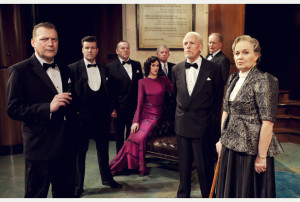It’s hard to review a whodunit – and particularly an Agatha Christie one – without writing about who did it. The beauty of the plot is in the way it is constructed so delicately by Christie, and then unravelled like a ball of wool leading to the final denouement where all is revealed and the audience gives a collective intake of breath.
So no spoilers here. But what I can tell you is that this play isn’t known as one of Christie’s best thrillers for nothing. It has the perfect ingredients – a cast of characters, all with their flaws and secrets, drawn by a mysterious puppeteer to a remote island cut off from the mainland to satisfy their own murderous intentions.
And Then There Were None gives away so much, yet also so little, in its title. Characters get bumped off one by one through the course of the play and it’s up to the dwindling band of survivors – and by proxy, the audience – to try and work out who the culprit is. To my mind they’d be better off trying to work out who the next victim is going to be, and try to prevent that, with the help of the handy Ten Little Soldier Boys rhyme hanging above the fireplace, but these people seem more intent on winding one another up than saving their own bacon.
Like in a 1930s Big Brother house, the cast gets “voted out” one by one until the final act where the killer is revealed, and there’s an eye-widening climax to the play. Christie’s original ending (from the novel) has been restored in director Joe Harmston’s version, and although it is grittier, more modern even, it still packs the punch that led to the original decision to lighten it up for the stage. I do have an issue with this restored ending – quite aside from the fact it sends you out of the theatre in a particular frame of mind, I just couldn’t bring myself to believe it. It’s hard to make a point about something you cannot explain, but I do wonder whether the original ending was adjusted for the stage for a good reason.
The 11-strong cast has fun along the way, especially the effervescent Verity Rushworth as secretary Vera Claythorne, and Mark Curry as the gradually disintegrating Dr Armstrong. There’s an eyebrow-raising performance from Paul Hassall as Anthony Marston (who thinks everything’s “wizard”) which at first I considered to be way out of kilter with the rest of the cast, but I soon realised that no, actually he’s brilliant, and I really enjoyed his interpretation of what is, in essence, an endearingly annoying character.
Susan Penhaligon channels her best Margaret Rutherford as religious zealot Emily Brent, while Paul Nicholas is calm and calculated as Sir Lawrence Wargrave. Ben Nealon gives a spirited, energetic turn as Philip Lombard, making the character unreadable most of the time – he’s portrayed as morally slippery, but at the same time is often cast as the hero figure. Colin Buchanan is fittingly gruff as William Blore (it’s no spoiler to mention his false identity here as it is so obvious from the start that he’s lying about who he is), while Frazer Hines gives an understated performance as butler Rogers. He has some lovely interplay with his wife Ethel that, if there were more of it, would serve the character better.
A stand-out performance for me was Eric Carte as General Mackenzie. The General has lost his wife Lesley, and has taken on a fatalistic approach to life, accepting that “we’re all going to die here” with very little resistance. Carte is touchingly melancholy as a man who obviously misses Lesley, dreams of her, wakes up and expects her to be back. There’s even a touch of dementia fed into Carte’s performance, and it gives a depth of character largely missing in the others. By and large, the characters are there to confess their secrets and get bumped off, and there’s little time along the way to flesh out (Brent aside, perhaps). These characters are written in broad yet informative strokes, but there is an added dimension to the General thanks to Carte’s considered performance.
One sad observation is that the set has certainly seen much better days. With any touring production like this, the sets are put up and taken down so often in different venues, often in haste, that there’s bound to be some wear and tear (this production has been on the road for six months already). But somebody really needs to take a step back and look at some of the damage – the scuff marks, the cobweb of fingerprints, the scratches and dents – which spoils what is supposed to be a lavish set. It’s designed so well that it’s a shame to see it in such a tired state, and it certainly benefits from Douglas Kuhrt’s impressive lighting in the third Act.
And Then There were None certainly does what it says on the tin, and it will genuinely keep you guessing, as all whodunits should. You’ll change your opinion as to who the killer is with every interlude (there are two 10-minute intervals), and you probably won’t guess the right one, but you’ll have a wizard time along the way!
And Then There Were None plays at the Pavilion Theatre, Rhyl, June 15th to 20th, then visits Cardiff’s New Theatre June 30th to July 4th and Swansea’s Grand Theatre September 7th to 12th, 2015.
